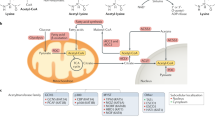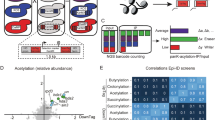Abstract
The activation of ATM is critical in the DNA double strand breaks repair pathway. Acetylation of ATM by Tip60 histone acetyltransferase (HAT) plays a key role in the activation of ATM kinase activity in response to DNA damage. ATM forms a stable complex with Tip60 through the FATC domain of ATM. Tip60 acetylates lysine3016 of ATM, and this acetylation induces the activation of ATM. Several techniques are included in the study of ATM acetylation by Tip60, such as in vitro kinase assay, systematic mutagenesis, western blots. Here, we describe how to study the acetylation of ATM using acetylation-specific antibodies.
Access this chapter
Tax calculation will be finalised at checkout
Purchases are for personal use only
Similar content being viewed by others
References
Lee JH, Paull TT (2004) Direct activation of the ATM protein kinase by the Mre11/Rad50/Nbs1 complex. Science 304:93–96
Lee JH, Paull TT (2005) ATM activation by DNA double-strand breaks through the Mre11-Rad50-Nbs1 complex. Science 308:551–554
Uziel T, Lerenthal Y, Moyal L, Andegeko Y, Mittelman L, Shiloh Y (2003) Requirement of the MRN complex for ATM activation by DNA damage. EMBO J 22:5612–5621
Carson CT, Schwartz RA, Stracker TH, Lilley CE, Lee DV, Weitzman MD (2003) The Mre11 complex is required for ATM activation and the G2/M checkpoint. EMBO J 22:6610–6620
Park BJ, Kang JW, Lee SW, Choi SJ, Shin YK, Ahn YH, Choi YH, Choi D, Lee KS, Kim S (2005) The haploinsufficient tumor suppressor p18 upregulates p53 via interactions with ATM/ATR. Cell 120:209–221
Kusch T, Florens L, Macdonald WH, Swanson SK, Glaser RL, Yates JR, Abmayr SM, Washburn MP, Workman JL (2004) Acetylation by Tip60 is required for selective histone variant exchange at DNA lesions. Science 306:2084–2087
Carrozza MJ, Utley RT, Workman JL, Cote J (2003) The diverse functions of histone acetyltransferase complexes. Trends Genet 19:321–329
Bird AW, Yu DY, Pray-Grant MG, Qiu Q, Harmon KE, Megee PC, Grant PA, Smith MM, Christman MF (2002) Acetylation of histone H4 by Esa1 is required for DNA double-strand break repair. Nature 419:411–415
Bakkenist CJ, Kastan MB (2003) DNA damage activates ATM through intermolecular autophosphorylation and dimer dissociation. Nature 421:499–506
Sun Y, Jiang X, Chen S, Fernandes N, Price BD (2005) A role for the Tip60 histone acetyltransferase in the acetylation and activation of ATM. Proc Natl Acad Sci USA 102:13182–13187
Sun Y, Xu Y, Roy K, Price BD (2007) DNA damage-induced acetylation of lysine 3016 of ATM activates ATM kinase activity. Mol Cell Biol 27:8502–8509
Jiang X, Sun Y, Chen S, Roy K, Price BD (2006) The FATC domains of PIKK proteins are functionally equivalent and participate in the Tip60-dependent activation of DNA-PKcs and ATM. J Biol Chem 281:15741–15746
Kim YC, Gerlitz G, Furusawa T, Catez F, Nussenzweig A, Oh KS et al (2009) Activation of ATM depends on chromatin interactions occurring before induction of DNA damage. Nat Cell Biol 11:92–96
Li H, Balajee AS, Su T, Cen B, Hei TK, Weinstein IB (2008) The HINT1 tumor suppressor regulates both gamma-H2AX and ATM in response to DNA damage. J Cell Biol 183:253–265
Eymin B, Claverie P, Salon C, Leduc C, Col E, Brambilla E et al (2006) p14ARF activates a Tip60-dependent and p53-independent ATM/ATR/CHK pathway in response to genotoxic stress. Mol Cell Biol 26:4339–4350
Author information
Authors and Affiliations
Corresponding author
Editor information
Editors and Affiliations
Rights and permissions
Copyright information
© 2017 Springer Science+Business Media LLC
About this protocol
Cite this protocol
Sun, Y., Du, F. (2017). Functional Characterization of ATM Kinase Using Acetylation-Specific Antibodies. In: Kozlov, S. (eds) ATM Kinase. Methods in Molecular Biology, vol 1599. Humana Press, New York, NY. https://doi.org/10.1007/978-1-4939-6955-5_12
Download citation
DOI: https://doi.org/10.1007/978-1-4939-6955-5_12
Published:
Publisher Name: Humana Press, New York, NY
Print ISBN: 978-1-4939-6953-1
Online ISBN: 978-1-4939-6955-5
eBook Packages: Springer Protocols




